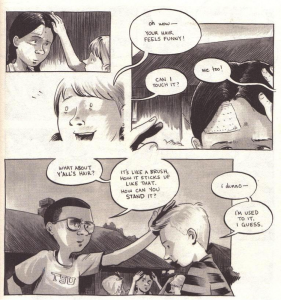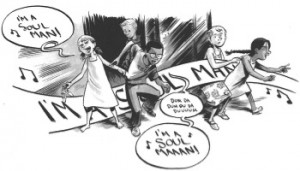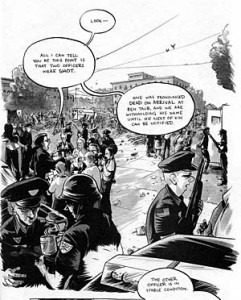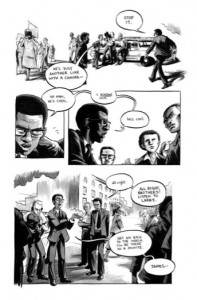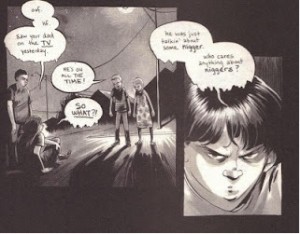Martin Luther King, Jr., used his right to free speech to fight one of the most important battles in American history, often — and ultimately — at great personal risk. In an era when many thought African Americans should not be afforded the same rights as white Americans, King raised his voice and encouraged others to do the same in the battle for equal rights. In running Using Graphic Novels in Education: The Silence of Our Friends today, CBLDF strives to remember King’s fight and the importance of the freedom of speech granted by the First Amendment in that fight.
Welcome to Using Graphic Novels in Education, an ongoing feature from CBLDF that is designed to allay confusion around the content of graphic novels and to help parents and teachers raise readers. In this column, we examine graphic novels, including those that have been targeted by censors, and provide teaching and discussion suggestions for the use of such books in classrooms.
 This month, we take a closer look at The Silence of Our Friends by Mark Long, Jim Demonakos and Nate Powell (First Second Books, 2012).
This month, we take a closer look at The Silence of Our Friends by Mark Long, Jim Demonakos and Nate Powell (First Second Books, 2012).
The Silence of Our Friends has not been banned or challenged to date, so we highlight it here for two reasons: First, in commemoration of the 50th anniversary on the March on Washington; and second, because this story then and now, powerfully relates the pain and ramifications of censorship and racism and the effects such silencing has on everyone.
The Silence of Our Friends is a semi-autobiographical story told from the perspective of Mark Long, as a boy. It centers around civil rights incidents covered by his father, a television reporter in Houston, Texas, in 1968, following the Texas Southern University student boycott after the Student Nonviolent Coordinating Committee (SNCC) was banned from campus. It ends with Dr. King’s assassination and the mourning of the larger Houston community as they marched in his memory that following Sunday. The Silence of our Friends emphasizes and reinforces Dr. Martin Luther King, Jr.’s powerful words:
In the end, we will remember not the words of our enemies but the silence of our friends.
BACKGROUND
In April 1967, the Student Nonviolent Coordinating Committee (SNCC) was banned from Texas Southern University’s campus, a historically African American college. Stokely Carmichael, the SNCC chairman, was increasingly portrayed in the media as an outside agitator who brought violence to any school allowing the SNCC on campus. It is for this reason that the organization was banned from Texas Southern University.
In reaction to the ban, TSU students boycotted classes and staged a sit-down protest on Wheeler Avenue, a street running through campus and the Third Ward that was known for racist whites who would cruise down Wheeler in cars and trucks, hurling obscenities (among other things) and often doing violence. That evening, the protest evolved into a police riot when an undercover officer was shot. Two hundred officers responded with massive rifle and machine gun fire and stormed a dormitory, arresting 489 Black students. All but five of the arrested students were released the next day. These five, who became known as the “TSU Five,” were charged with the officer’s murder. Only one of the five accused stood trial (in Victoria, Texas due to the extensive and heated publicity in Houston), and charges were dismissed after it was discovered that the officer was accidentally shot by another officer.
BOOK OVERVIEW
In their graphic novel, Long, Demonakos, and Powell clearly and powerfully relate the struggles of two families — one White, one Black — as they deal with violence, degradation, and humiliation in their respective fights for civil rights in the 1960s. They sensitively relate the daily issues facing the adults and their children while allowing readers to witness the social upheaval on a local level in Houston.
Powell’s black and white images empower viewers to understand multiple perspectives of those volatile times as we intimately view the unfolding events. The accompanying text at times contains strong language and racial slurs, illustrating and accurately relaying this tumultuous time. This book encapsulates the late 1960s and will likely become a staple in all any schools, homes, and libraries. It is powerful and empowering and while showing a dark period in our history, it also shows how friendship and justice can help us all overcome.
SUMMARY
The book opens with Mark and his sister playing outside while Mom, inside, irons in front of the television, visibly upset as she witnesses the televised murder of a Vietcong soldier. When Dad (Jack Long) comes home ,the family sits down for dinner, says Grace, and then discusses the shooting and the war as they eat. After dinner the kids go out to play. A neighborhood friend asks if they want to “go nigger knockin’” (ringing doorbells and running). Mark tells his blind sister Julie that she can’t join them because she’s blind and might get hurt. When the Longs hear their kids went “nigger knockin’,” they’re furious and tell them never to talk like that again.
Throughout the book, we see snippets of life in Houston and in Houston’s Third Ward in particular. We see the kids playing in their respective neighborhoods, and at school, we see the Longs at a rodeo, a flyer for a rally sponsored by the “Harris County Klan” in one panel, and another panel showing the Dean of Students “regretfully” telling students the SNCC has been banned from campus.
On campus, we see student disapproval and then meet Larry Thompson, who tells protesters that the administration has no right to do this. Jack Long is reporting on this gathering, and while the SNCC Brothers think “he’s just another liar with a camera,” Larry vouches for Jack. A few panels later, we see Larry at home and much to the astonishment (and fear) of his wife, Larry says he’s thinking of inviting the Longs to their home. We soon see the Thompsons visiting the Longs and how the latter’s neighbors react to this visit. A notable scene of the early interaction between the Longs and Thompsons is one in which the Long kids are awed at the texture of the Thompson kids’ hair, as the Thompsons are in turn awed by the Longs’.
As the story progresses, we see the spilt in political opinions at Jack’s television station and how his coverage is pitted between its racist owner and sympathetic manager. We also witness factors leading up to the Wheeler Avenue protest and how what begins as a peaceful sit-in becomes violent. After the ensuing violence, we then see how the white district attorney and so many others tried to turn the death of a police officer into “a lynch job.” At one point Larry misjudges and mistrusts Jack, and Jack must fight for the truth and what in his heart he deems right — even if it means losing everything.
Throughout the book we see, hear, and feel the varied opinions held by Houston citizens about the banning of the SNCC, as well as their views on segregation. And, while the banning of the SNCC and the subsequent Wheeler Avenue protest are the main elements around which the story is built, it is actually the smaller moments in each character’s life, as they try to do what is right, that grip the reader. It is the combined daily struggles illustrated in the Thompsons’ inability to buy bait because no Blacks are allowed, or Julie’s struggle to “see” and learn braille, or the risk prisoners (all Black) take at the rodeo to make some money for their impoverished families, or the racist remarks of joy-riders down Wheeler, or the divisive opinions of television station owner versus its station manager that so totally reflect the tensions of that time. It is these moments we’re allowed to share with the characters that empower us to feel the fight for civil rights in the late 1960s.
To help us more fully understand those times, Long, Demonakos, and Powell offer us the words of Dr. Martin Luther King as pillars of strength and hope and they add the struggle of a blind girl — a metaphor for seeing and reading life as it could and should be. The stories are brilliantly woven and serve as concrete examples of the power of words and metaphor.
In short this is a story about the civil rights issues in the late 1960s — how it was dealt with and how it was lived from various points of view. It is a story of protest, and of growing trust and friendships, of unknowing heroes, of breaking customs and unworthy behavioral patterns, and it is the painstaking story of finding and learning to see the truth in front of us.
Throughout The Silence of our Friends, Long, Demonakos ,and Powell relay:
- The importance of perspective and of considering diverse points of view;
- The effects of racism and blind acceptance of “fact” and of “accepted” status-quo;
- A community’s coming of age in its struggle for civil rights;
- The development of local and of national heroes and understanding how these heroes come to be;
- The power of the peoples’ voice in a democratic republic;
- The powers and limits of local and national government, especially in times of civic unrest;
- The ways and means of achieving change in a democratic republic;
- The struggle in understanding how to use and balance civic responsibilities in times of civic unrest;
- The struggles nations and individuals must endure when fighting for their principles and ideals;
- The different ways people find the courage to stand up and fight for their rights;
- The power of metaphor, in this case for “seeing” and “hearing” the truths within and around us;
- The power of friendship and the occasional roadblocks friendships must overcome in times of trouble.
TEACHING/DISCUSSION SUGGESTIONS:
Cultural Diversity, Civic Responsibilities, and Social Issues
- Analyze how the book’s different characters dealt with racism. Ask students how they might deal with racist comments, practices and restrictions.
- Discuss what it must have felt like to be excluded from busses, shops, and community services.
- Discuss when people should forgive and forget and when people should fight or stand up for themselves and their community.
- Compare and contrast the attitudes of the Black and White characters in the book. Discuss how are they similar/different.
- Research, present and discuss the personal backgrounds, public struggles, and the articles and speeches of local and national figures of the civil rights movement.
- Compare and contrast news coverage of social unrest in this country in the 1960 versus news coverage of social unrest today:
- Discuss the similarities and differences of local, national, and international issues of the 1960’s versus those of today.
- Discuss how the news was disseminated then and how it is disseminated today.
- Discuss how technology and ‘modern lifestyles’ effect the way news is reported.
- Define and discuss “racism”
- Discuss the different instances of discrimination and racism presented throughout the book. Discuss instances of racism today on local, national and international scenes.
- How is it the same/different across time and geographic locations (nationally and/or internationally)?
- How has racism changed today, if at all?
- Discuss the different instances of discrimination and racism presented throughout the book. Discuss instances of racism today on local, national and international scenes.
- Compare racism towards Blacks versus racism towards other peoples, races and religions. How is it the same/different?
- Discuss how hurtful racism can be — to those targeted as well as to the general population.
- Discuss how racism has influenced, shaped and determined national and international policies and politics.
- Discuss what can be done today to fight racism and discrimination and ways students can help.
Language, Literature, and Language Usage
- Search for, define, and discuss the book’s use of racist language and phrases. For example:
- On page 26, Larry Thompson shouts: “The whole administration is Uncle Toms.”
- On page 85, as a truck runs by the Thompson kids riding their bikes on Wheeler Avenue and shouts, “Get out of the street ya lil’ jigaboos!!”
- Find and list others. Compare and contrast racist slurs of today versus those of the 1960s.
- Plot and compare the authors’ use of vocabulary, slang, idioms, and images as they depict Black versus White sentiment. Is there a difference in their use of language?
- Have students collect family stories (oral, written, and/or photographed) of the 1960s and civil rights movement, marches, and protests, and/or stories of racism and segregation. [Note: There were and still are incidents of racism and segregation experienced by minority and immigrant families as well. To include all your students, you may want to expand your discussion/project to the comparing and contrasting racist incidents directed at various targeted groups.]
- On pages 79-83, we join the Thompsons at a church service and listen to the sermon: a story of Paul, “who was also called Saul…who breathed …threats of slaughter against the disciples…and he was a party to murder. A party to hate…But on the road to Damascus, on his way with letters of arrest… he was struck blind by the lord…and for three days and three nights Saul prayed…and the believer named Ananias…put his hands on [Saul and said] ‘Brother Saul, Jesus has sent me, that thou might receive sight… and he could see the truth…and so do WE suffer from blind hatred…” Discuss the authors’ use of inference and metaphor in this story and how the reference to Paul relates to the town’s own issues.
- Search and discuss other uses of inference and metaphor, including Julie’s struggle to learn braille and to “see” texts and events around her.
- Discuss some of Long and Demonakos’ use of language. For example:
- Discuss how the rodeo queen (p.48) announces: “Okay folks, comin’ up HARD MONEY! Y’all know this one…” Discuss why they call it hard money and what the inference is about.
- Discuss the authors’ description of Otis trial as a “lynch job”(p. 57), and how this phrase has been used through history.
- Discuss Larry Thompson’s noting (p.97) that “Men of conscience have to join together…or nothing is going to change.” Analyze the term “men of conscience” — who these men are, and why it was used here.
Modes of Storytelling and Visual Literacy
In graphic novels, images are used to relay messages with and without accompanying text, adding additional dimension to the story. Compare and contrast the authors’ use of verbal versus visual imagery. Discuss with students how images can be used to relay complex messages. For example:
- This story is all about individual incidents of racism and discrimination. Have students hunt for visual and verbal examples, comparing how they are relayed through language and how they are relayed through image. Discuss the impact of these various forms of communication.
- For parts of the story, Powell relays his images against a black background while others are relayed against a white background. Chart when he does each and discuss why this might be. Discuss how page design and backgrounds help communicate the story and its messages.
- Some of the Wheeler Avenue demonstration and violence is shown in typical panels, some is shown without any panels and some is shown on a television screen. Discuss how these different image forms help tell the story. Evaluate how effective this is.
- In the final scene, the March in memory of Dr. King, note how Powell’s use of page and image changes. Discuss how the illustrations communicate individual sentiment as well as that of the overall community. Why is it that the final images of the story show feet gradually lifting off the pavement?
Suggested Prose Novel and Poetry Pairings
For greater discussion on literary style and/or content here are some prose novels and poetry you may want to read with The Silence of Our Friends
- To Kill a Mockingbird by Harper Lee — an American classic about a town struggling with racism and a trial that brings two families from opposing sides of the civil rights conflict to the forefront.
- March, a graphic novel by Congressman John Lewis, Andrew Aydin, and Nate Powell — This first volume spans Lewis’ youth in rural Alabama, his meeting with Dr. Martin Luther King Jr., the birth of the Nashville Student Movement, and their battle against segregation. (Note: This book has an awesome teacher’s guide, too.)
- I Have a Dream: Writings and Speeches That Changed the World by Martin Luther King Jr. — the text of King’s famous speech.
- Martin’s Big Words: The Life of Dr. Martin Luther King Jr. by Doreen Rappaport and Bryan Collier (illustrator) — an extraordinary picture-book biography, incorporating narrative, famous quotes from Dr. King, and powerful collage and watercolor illustrations introducing King’s words and legacy to younger readers.
- Coming of Age in Mississippi by Anne Moody — an autobiography of a poor Black girl whose parents were tenant farmers on a Mississippi plantation and whose dream of going to college was realized upon winning a basketball scholarship. We get first-hand accounts of her joining the NAACP, CORE, and SNCC and the steps she took in demonstrations and sit-ins, along with her subsequent arrests and jailings.
- Through My Eyes: Ruby Bridges by Ruby Bridges, Margo Lundell (Editor) — Ruby Bridges chronicles her steps in November 1960 as a six-year-old Black girl, surrounded by federal marshals who walked her through a mob of screaming segregationists into school.
- For older readers (high school and older):
- Their Eyes Were Watching God by Zora Neale Hurston — novel about Janie Crawford, a proud, independent Black woman whose quest for identity and has become a highly acclaimed expression of African-American literature.
- I Know Why the Caged Bird Sings by Maya Angelou — autobiography about poet and writer Maya Angelou’s early years. She writes about women’s lives in a male-dominated society, and uses metaphors of rape (the suffering of her race) and a caged bird trying to escape throughout the book.
- In Struggle: SNCC and the Black Awakening of the 1960s by Clayborne Carson — Using primary resources (interviews, meeting transcripts, and recently released FBI papers), Carson describes the SNCC story from its start-up as the earliest civil rights fighters (its sit-ins, freedom rides, organized voter registration) to sparking wider social protests against the Vietnam War. This book goes behind the scene and takes a look at the organizations accomplishments and internal and often bitter power struggles.
- The Color Purple by Alice Walker — about Celle, a Southern Black woman sold into a live of servitude to her brutal sharecropper husband and her struggle to find her own way.
Common Core State Standards:
This book of assimilation and racial tolerance is full of advanced vocabulary, simile, slang, idioms, and cultural folklore. It promotes critical thinking, relates a hero and a coming of age story laden with issues of identity, justice and friendship, provides verbal and visual story telling that addresses multi-modal teaching, and meets Common Core State Standards including:
- Key ideas and details: Citing textual evidence, determining a theme or central idea, describing how a plot unfolds, analyzing how particular elements of the story interact; analyzing how particular lines of dialogue or incidents of a text reveal aspects of a character or provoke a decision; analyzing a particular point of view or cultural experience reflected in a work of literature from outside the United States, drawing on a wide reading of world literature.
- Craft and structure: Determining the meaning of words and phrases including figurative and connotative meaning; analyzing how particular sentences, chapters, scenes or stanzas fit into the overall structure of a text; explaining how a point of view is developed; analyzing how a text’s structure or form contributes to its meaning; analyzing a particular point of view or cultural experience reflected in a work of literature from outside the United States, drawing on a wide reading of world literature; determining the meaning of words and phrases as they are used in a text, including vocabulary specific to domains related to history/social studies; describing how a text presents information
- Integration of knowledge and ideas: Comparing and contrasting texts; distinguishing among fact, opinion, and reasoned judgment in a text; analyzing how a modern work of fiction draws on themes, patterns of events, or character types from myths, traditional stories, or religious works describing how the material is rendered new; analyzing how an author draws on and transforms source material in a specific way..
- Range of reading and level of text complexity: By the end of the year, read and comprehend literature, including stories, dramas, and poems, in the grades 6-8, and in the grades 8-10 text complexity band proficiently, with scaffolding as needed at the high end of the range.
- Knowledge of language: Using knowledge of language and its conventions when writing, speaking, reading, or listening; applying knowledge of language to understand how language functions in different contexts, to make effective choices for meaning or style and to comprehend more fully when reading or listening.
- Vocabulary acquisition and use: Determining the meaning of unknown and multiple-meaning words and phrases; demonstrating understanding of figurative language, word relationships, and nuances in world meanings; and acquiring and using accurately grade-appropriate general academic and domain-specific words and phrases.
- Research to build and present knowledge: Drawing evidence from literary or informational texts to support analysis, reflection, and research;
- Comprehension and collaboration: Engaging effectively in a range of collaborative discussions building on others’ ideas and expressing their own clearly.
- Presentation of knowledge and ideas: Presenting claims and findings, sequencing ideas logically and using pertinent descriptions, facts, and details to accentuate main ideas or themes.
This book and related discussions also cover the following themes identified by The National Council for the Social Studies:
- Culture and Cultural Diversity – “…students need to comprehend multiple perspectives … to consider the strengths and advantages that this diversity offers to the society in general and to their own growth…to analyze the ways that a people’s cultural ideas and actions influence its members…”
- Time, Continuity, and Change – “…facilitate the understanding and appreciation of differences in historical perspectives and the recognition that interpretations are influenced by individual experiences, societal values, and cultural traditions… examine the relationship of the past to the present and extrapolating into the future… provide learners with opportunities to investigate, interpret, and analyze multiple historical and contemporary viewpoints within and across cultures related to important events, recurring dilemmas, and persistent issues, while employing empathy, skepticism, and critical judgment…”
- Individual Development and Identity – “…describe how family, religion, gender, ethnicity, nationality, socioeconomic status, and other group and cultural influences contribute to the development of a sense of self…have learners compare and evaluate the impact of stereotyping, conformity, acts of altruism, discrimination, and other behaviors on individuals and groups…”
- Individuals, Groups, and Institutions – “…help learners understand the concepts of role, status, and social class and use them in describing the connections and interactions of individuals, groups, and institutions in society…analyze groups and evaluate the influence of institutions, people, events, and cultures in both historical and contemporary settings…identify and analyze examples of tensions between expressions of individuality and efforts of groups and institutions to promote social conformity…”
- Power, Authority, and Governance – “…understanding the historical development of structures of power, authority, and governance and their evolving functions in contemporary American society… enable learners to examine the rights and responsibilities of the individual in relation to their families, their social groups, their community, and their nation… examine issues involving the rights, roles, and status of individuals in relation to the general welfare…explain conditions, actions, and motivations that contribute to conflict and cooperation within and among nations…challenge learners to apply concepts such as power, role, status, justice, democratic values, and influence…”
- Civic Ideals and Practices – “…assist learners in understanding the origins and continuing influence of key ideals of the democratic republican form of government, such as individual human dignity, liberty, justice, equality, and the rule of law…analyze and evaluate the influence of various forms of citizen action on public policy…evaluate the effectiveness of public opinion in influencing and shaping public policy development and decision-making…”
ADDITIONAL RESOURCES:
- Martin Luther King, Jr. I Have a Dream speech – text and audio
- http://www.loc.gov/teachers/classroommaterials/themes/civil-rights/exhibitions.html – multimedia resources from the Library of Congress that support the teaching about civil rights
- Historical places of the civil rights movement – We Shall Overcome: A National Register of Historic Places Travel Itinerary with an introduction, itinerary maps, list of sites and links to learn more.
- http://www.academicinfo.net/africanamcr.html – civil rights history resource.
- http://www.pbs.org/teachers/thismonth/civilrights/index1.html – Teaching ideas for teaching the civil rights movement in American literature (all grade levels)
- http://www.crmvet.org/poetry/poemhome.htm – poems of the Freedom Movement
- http://www.whyy.org/generations/oral.html – guide for students on how to conduct oral history interviews with samples of American slave narratives and other primary resource sets
- http://www.history.com/search?q=civil+rights+movement&x=0&y=0 – History channel list of links and resources
- http://www.goodreads.com/shelf/show/civil-rights-movement and http://www.slj.com/2013/01/books-media/collection-development/focus-on-collection-development/civil-rights-everyday-heroes-focus-on-january-2013/ – provides extensive lists for further reading on the civil rights movement for students of varying ages and reading levels.
In celebration of Black History Month, CBLDF will be featuring graphic novels by African American creators in the Using Graphic Novels column throughout February. Return to CBLDF.org for teaching ideas, resources, and more.
Meryl Jaffe, PhD teaches visual literacy and critical reading at Johns Hopkins University Center for Talented Youth OnLine Division and is the author of Raising a Reader! and Using Content-Area Graphic Texts for Learning. She used to encourage the “classics” to the exclusion comics, but with her kids’ intervention, Meryl has become an avid graphic novel fan. She now incorporates them in her work, believing that the educational process must reflect the imagination and intellectual flexibility it hopes to nurture. In this monthly feature, Meryl and CBLDF hope to empower educators and encourage an ongoing dialogue promoting kids’ right to read while utilizing the rich educational opportunities graphic novels have to offer. Please continue the dialogue with your own comments, teaching, reading, or discussion ideas at meryl.jaffe@cbldf.org and please visit Dr. Jaffe at http://www.departingthe text.blogspot.com.
All images (c) Mark Long, Jim Demonakos, Nate Powell

